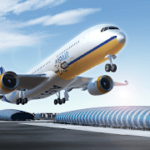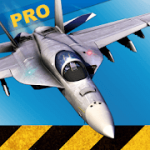F18 Carrier Landing APK for android
RORTOSReleased on
Sep 26, 2011Updated
Oct 23, 2023Size
131.2 MbVersion
7.5.8Requirements
5.1Downloads
100,000+Get it on
Description
App Information
F18 Carrier Landing is an important part of naval aviation that shows how skilled and accurate military pilots are as they fly and land high-performance fighter planes on the narrow deck of an aircraft carrier. What is the history of F18 carrier landings? What are the challenges? How do you train for them? What are the future prospects?
History and Development of F18
Since its initial release in the late 1970s, the F18, made by McDonnell Douglas (now Boeing) and Northrop, has been a significant component of military aviation. At first, it was meant to be a flexible fighter plane, but it quickly became clear that it could also operate from aircraft carriers, which led to the creation of versions that could be used from carriers.
Why carrier landings are important
Carrier landings are important for naval operations because they let fighter jets fly from mobile platforms at sea, which gives navy forces more power and reach. The F18’s ability to land on a carrier makes it more useful for maritime tasks like air defence, reconnaissance, and ground support.
The F18 Carrier Landing Training Programme
To master F18 carrier landing, you need a lot of training and skill. Pilots go through a lot of training flights and simulations to get better at landing, approaching, and taking off in a variety of situations. Safety, accuracy, and good contact between pilots and deck crews are stressed in training programmes.
What Makes Up a Carrier Landing
A good carrier landing is made up of several important parts:
- Approach: Pilots must keep their speed and altitude exactly the same while they line up with the deck of the ship.
- Arresting Gear: When the plane touches down, its tailhook triggers the arresting gear, which quickly stops the jet.
- Touchdown: The pilots do a controlled landing with the goal of making smooth contact with the deck of the ship.
- Catapult Launch: Before takeoff, powerful catapults are used to launch jets from the deck of the ship, which speeds them up and lets them rise quickly.
Important Things
Before you start to explore the world of our advanced flight simulator and aircraft carrier landing system, let’s take a closer look at the things that make it unique:
1. Interesting Campaigns and Case Studies:
Our simulator has an interesting campaign mode with two dynamic scenarios and training tasks. No matter how experienced or new you are as a pilot, these tasks will test your skills and keep you entertained for hours.
2. Large-Screen Flight Simulator:
Pilots can explore more than 500 correctly modelled airports with access to terrain from around the world and a full navigation system. Feel the thrill of flying over a wide range of landscapes, from busy cities to remote wilderness areas, all of which are drawn with amazing accuracy and detail.
3. Mode of free flight:
If you’d rather make your own plans, our free flight mode lets pilots change the time and weather choices to suit their needs. When you fly and see the world from above, you can choose whether it’s a clear, sunny day or a rainy night.
4. Landing contests with prizes:
Our events let you show off your landing skills against the best pilots in the world. You can compete on a global leaderboard as you try to land perfectly on air bases and aircraft carriers, getting better at accuracy and finesse with each landing.
5. Three-Cam Replay:
With our multi-camera replay tool, you can relive your most exciting moments. You can look back at and analyse your flights from any angle, from dynamic movie angles to cockpit views. This lets you learn useful things and make your flying better.
6. A Wide Range of Aircraft and Skills:
Our simulator has a wide range of planes, from the famous F/A-18 Super Hornet to the quick F35B Lightning II. Each plane has its own features and abilities. Vertical takeoffs and landings, as well as refuelling while in the air, are just a few of the difficulties and manoeuvres that pilots can experience.
7. Weather Conditions That Are Real:
Get ready for the weather with our accurate weather simulator. When the weather changes quickly, like from strong winds and heavy rain to snowstorms and lightning strikes, you’ll need to change how you’re flying to stay safe.
8. A detailed virtual cockpit in 3D:
Our realistic 3D virtual cockpit lets you step into the cockpit and feel like you’re really there. Every detail, from the built-in instruments to the rain and snow effects, has been carefully thought out to make the flying experience feel real.
9. Radar System for Navigation:
Use our radar guidance system to accurately navigate. It gives you important information about the direction of the runway and aircraft carrier. This feature makes sure you stay on course and on target, even when you’re making a critical approach or landing in tough weather.
10. Radio communication that is interactive:
Add interactive radio contact so that pilots can talk to air traffic control and other planes. This will make the experience more realistic. As you fly through busy areas and do complicated manoeuvres, stay informed and coordinated.
Our advanced flight simulator and aircraft carrier landing system have all of these features and more, making them the best ways to experience flying ever. For anyone who likes aeroplanes, whether they’ve done it before or not, get ready to be amazed as you learn how to fly.
F18 Carrier Landing Problems
F18 ship landings are challenging for a number of reasons, including bad weather, the carrier’s moving deck, mechanical issues with the landing gear, and the high level of skill required by the pilots. Bad weather can make ship landings even more difficult, so pilots need to be very focused and accurate.
Safety precautions and steps to take
Safety is still the most important thing in F18 carrier missions. Strict regulations that include thorough pre-flight checks, ongoing training, and effective communication systems reduce the risks of ship landings to a minimum. New technologies, like automated landing systems and better deck tools, make things even safer and more efficient.
Using technology to land a carrier
Technology improvements have changed how ship landing operations are done. Modern versions of the F18 have more advanced avionics, guidance systems, and flight control software, which makes it easier for the pilot to see what’s going on around them and land precisely. Unmanned aerial vehicles (UAVs) and drones that are attached to carriers are also different ways to do maritime flying.
Important F18 carrier landings
Naval aviators have shown their skill and bravery many times throughout history through F18 ship landings. These achievements show how useful and dependable the F18 is in maritime settings, from normal tasks to emergency landings during war missions.
What’s Next for F18 Carrier Landing?
As military aviation changes, the future of landing on an F18 carrier looks bright. The F18 will continue to be an important part of naval aviation for years to come as new aircraft, training methods, and tactical strategies are developed. These changes are meant to make carrier-based operations even more efficient, safe, and effective.
In conclusion
The F18 carrier landing is the most precise and skilled military flight ever. No matter how it got its start or what part it plays in modern maritime operations, the F18 keeps pushing the limits of what is possible in carrier-based aviation. With continued progress and unwavering commitment, the F18 carrier landing is sure to be remembered for many years to come.
FAQs
- How fast do F18 jets land on aircraft carriers?
- F18 jets typically land at speeds ranging from 120 to 150 knots, depending on various factors such as aircraft weight and carrier deck conditions.
- What is the role of the tailhook in carrier landings?
- The tailhook, located at the rear of the aircraft, catches arresting wires on the carrier deck, allowing the jet to rapidly decelerate and come to a stop.
- How do pilots train for F18 carrier landings?
- Pilots undergo extensive simulator training and live flight exercises, practicing approach, touchdown, and takeoff maneuvers under different scenarios and conditions.
- What challenges do pilots face during carrier landings?
- Pilots must contend with factors such as adverse weather, motion of the carrier deck, and mechanical failures, requiring exceptional skill and concentration to execute safe landings.
- Are there alternative landing methods for F18s on carriers?
- While traditional arrested landings are standard, advancements in technology have led to the exploration of alternative landing methods, including autonomous systems and UAV operations.
Was this helpful?
Images
Video
What's new
Bug fixes
Versions
| Version | Size | Requirements | Date |
|---|---|---|---|
| 7.5.2 | 39M | 5.0 and up | 05/03/2020 |
Applied Patches
Full Version

















